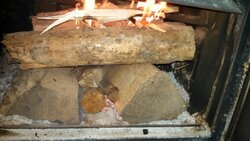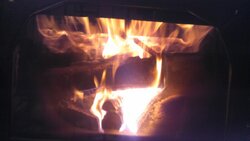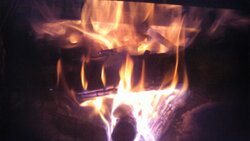Recently the question has come up about how quickly a stove of large mass can get up to temperature. It's finally getting cool here so I decided to time some fire starts. I noticed last night with a cold start that the stove warmed up pretty quickly, but didn't time it. This morning I did watch the clock. This first timing was with a slightly warm stove from last night's fire.
Temp this morning was 40F. We had a medium sized fire last night, but only cold coals this morning when I got up. The stove was still slightly warm to the touch, maybe about 110F. I put in 5 doug fir splits with a chunk of super cedar. The dry wood took off immediately. 11 minutes later the stove top was at 300F, heat was radiating from the glass and I turned the air down to about 1/4 open. Secondary combustion was present and active. At 20 minutes the stove top was 425F with good secondary combustion. I added one more split to the middle to even out the load. At 30 minutes stove top temp was 510F. Good heat was convecting off the top and the front was quite radiantly hot. At 60 minutes the stove was close to cruising temperature of 625F. It might creep up to 650F. Air was turned down al little more to 1/8 open. Living room temp was 71F, house temp in the hall at the thermostat was 69F.
I'll do this test again with a stone cold stove for comparison.
Temp this morning was 40F. We had a medium sized fire last night, but only cold coals this morning when I got up. The stove was still slightly warm to the touch, maybe about 110F. I put in 5 doug fir splits with a chunk of super cedar. The dry wood took off immediately. 11 minutes later the stove top was at 300F, heat was radiating from the glass and I turned the air down to about 1/4 open. Secondary combustion was present and active. At 20 minutes the stove top was 425F with good secondary combustion. I added one more split to the middle to even out the load. At 30 minutes stove top temp was 510F. Good heat was convecting off the top and the front was quite radiantly hot. At 60 minutes the stove was close to cruising temperature of 625F. It might creep up to 650F. Air was turned down al little more to 1/8 open. Living room temp was 71F, house temp in the hall at the thermostat was 69F.
I'll do this test again with a stone cold stove for comparison.





 )
)